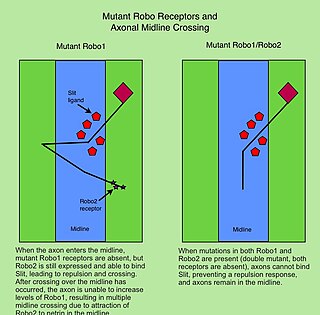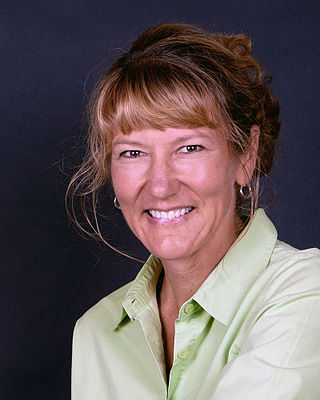Related Research Articles

An axon or nerve fiber is a long, slender projection of a nerve cell, or neuron, in vertebrates, that typically conducts electrical impulses known as action potentials away from the nerve cell body. The function of the axon is to transmit information to different neurons, muscles, and glands. In certain sensory neurons, such as those for touch and warmth, the axons are called afferent nerve fibers and the electrical impulse travels along these from the periphery to the cell body and from the cell body to the spinal cord along another branch of the same axon. Axon dysfunction can be the cause of many inherited and acquired neurological disorders that affect both the peripheral and central neurons. Nerve fibers are classed into three types – group A nerve fibers, group B nerve fibers, and group C nerve fibers. Groups A and B are myelinated, and group C are unmyelinated. These groups include both sensory fibers and motor fibers. Another classification groups only the sensory fibers as Type I, Type II, Type III, and Type IV.
Axon guidance is a subfield of neural development concerning the process by which neurons send out axons to reach their correct targets. Axons often follow very precise paths in the nervous system, and how they manage to find their way so accurately is an area of ongoing research.

Netrins are a class of proteins involved in axon guidance. They are named after the Sanskrit word "netr", which means "one who guides". Netrins are genetically conserved across nematode worms, fruit flies, frogs, mice, and humans. Structurally, netrin resembles the extracellular matrix protein laminin.

Neuron is a biweekly peer-reviewed scientific journal published by Cell Press, an imprint of Elsevier. Established in 1988, it covers neuroscience and related biological processes.

Roundabout homolog 2 is a protein that in humans is encoded by the ROBO2 gene.

Cornelia Isabella "Cori" Bargmann is an American neurobiologist. She is known for her work on the genetic and neural circuit mechanisms of behavior using C. elegans, particularly the mechanisms of olfaction in the worm. She has been elected to the National Academy of Sciences and had been a Howard Hughes Medical Institute investigator at UCSF and then Rockefeller University from 1995 to 2016. She was the Head of Science at the Chan Zuckerberg Initiative from 2016 to 2022. In 2012 she was awarded the $1 million Kavli Prize, and in 2013 the $3 million Breakthrough Prize in Life Sciences.

The Roundabout (Robo) family of proteins are single-pass transmembrane receptors that are highly conserved across many branches of the animal kingdom, from C. elegans to humans. They were first discovered in Drosophila, through a mutant screen for genes involved in axon guidance. The Drosophila roundabout mutant was named after its phenotype, which resembled the circular traffic junctions. The Robo receptors are most well known for their role in the development of the nervous system, where they have been shown to respond to secreted Slit ligands. One well-studied example is the requirement for Slit-Robo signaling in regulation of axonal midline crossing. Slit-Robo signaling is also critical for many neurodevelopmental processes including formation of the olfactory tract, the optic nerve, and motor axon fasciculation. In addition, Slit-Robo signaling contributes to cell migration and the development of other tissues such as the lung, kidney, liver, muscle and breast. Mutations in Robo genes have been linked to multiple neurodevelopmental disorders in humans.
Christine Elizabeth Holt is a British developmental neuroscientist.
Slit-Robo is the name of a cell signaling protein complex with many diverse functions including axon guidance and angiogenesis.

The growth cone is a highly dynamic structure of the developing neuron, changing directionality in response to different secreted and contact-dependent guidance cues; it navigates through the developing nervous system in search of its target. The migration of the growth cone is mediated through the interaction of numerous trophic and tropic factors; netrins, slits, ephrins and semaphorins are four well-studied tropic cues (Fig.1). The growth cone is capable of modifying its sensitivity to these guidance molecules as it migrates to its target; this sensitivity regulation is an important theme seen throughout development.
UNC is a set of proteins first identified through a set of screening tests in Caenorhabditis elegans, looking for roundworms with movement problems. Worms with which were un-coordinated were analysed in order to identify the genetic defect. Such proteins include UNC-5, a receptor for UNC-6 which is one of the netrins. Netrins are a class of proteins involved in axon guidance. UNC-5 uses repulsion (genetics) to direct axons while the other netrin receptor UNC-40 attracts axons to the source of netrin production.
UNC-5 is a receptor for netrins including UNC-6. Netrins are a class of proteins involved in axon guidance. UNC-5 uses repulsion to direct axons while the other netrin receptor UNC-40 attracts axons to the source of netrin production.

Linda Richards is an Australian researcher at Queensland Brain Institute (QBI) at the University of Queensland.

Susan McConnell is a neurobiologist who studies the development of neural circuits in the mammalian cerebral cortex. She is a professor in the Department of Biology at Stanford University, where she is the Susan B. Ford Professor of Humanities and Sciences, a Bass University Fellow, and a Howard Hughes Medical Institute Professor. She is an elected member of the National Academy of Sciences and the American Academy of Arts and Sciences.
Jeffrey D. Macklis is an American neuroscientist. He is the Max and Anne Wien Professor of Life Sciences in the Department of Stem Cell and Regenerative Biology and Center for Brain Science at Harvard University, Professor of Neurology [Neuroscience] at Harvard Medical School, and on the Executive Committee and a Member of the Principal Faculty of the Neuroscience / Nervous System Diseases Program at the Harvard Stem Cell Institute.
Carol Ann Mason is a Professor of Pathology and Cell Biology at Columbia University in the Mortimer B. Zuckerman Mind Brain Behavior Institute. She studies axon guidance in visual pathways in an effort to restore vision to the blind. Her research focuses on the retinal ganglion cell. She was elected a member of the National Academy of Sciences in 2018.
Alain Chédotal is a French researcher specialising in the development of neural circuits. He has been a member of the French Academy of sciences since 2017.
Esther Stoeckli is a Swiss neuroscientist at the University of Zurich and the director of the Institute of Molecular Life Sciences. Her research focuses on the molecular mechanisms that underlie the establishment of neuronal circuits.
Oscar Marín Parra FMedSci FRS is a Spanish and British neuroscientist. He is married to neuroscientist Beatriz Rico.

Corinne Houart is a Belgian biomedical scientist who is Professor of Developmental Neurobiology at King's College London. She also serves as Vice Dean for Research in the Institute of Psychiatry, Psychology, and Neuroscience at King's College London. She is a leading international researcher with a focus on the molecular and cellular mechanisms that drive zebrafish forebrain development, and evolutionary mechanisms underlying vertebrate brain regionalisation.
References
- ↑ "A Career in Science Editing: Katja Brose (Editor in Chief, Neuron)". Neuronline. Washington, DC: Society for Neuroscience. 2015. Retrieved 2 June 2016.[ permanent dead link ] Transcript and video available. Click on "Transcript" for text.
- See also: A Career in Science Editing: Katja Brose Editor in Chief, Neuron
- 1 2 Member Profiles (2015). "Katja Brose". The National Academies of Sciences, Engineering, and Medicine. National Academy of Sciences . Retrieved 2 June 2016.